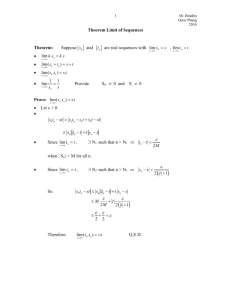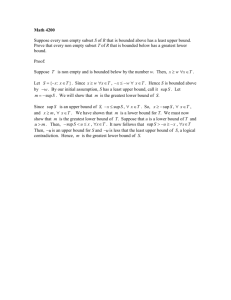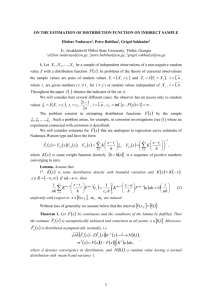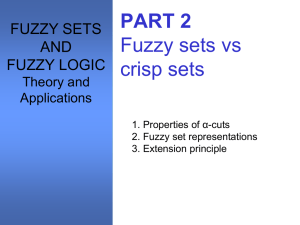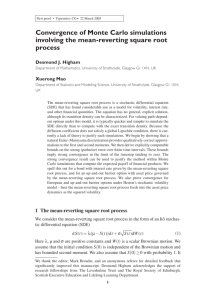Extension principle method --(4.9) e.g. *=+ Theorem 4.2 : A , B
advertisement
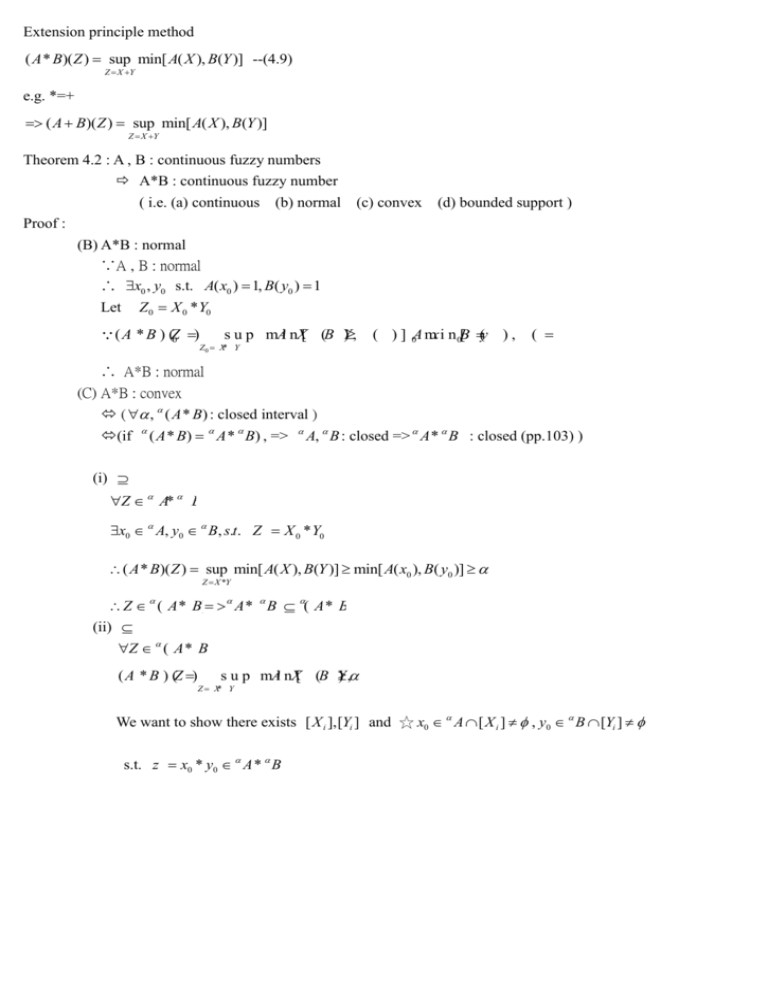
Extension principle method
( A * B)( Z ) sup min[ A( X ), B(Y )] --(4.9)
Z X Y
e.g. *=+
( A B)( Z ) sup min[ A( X ), B(Y )]
Z X Y
Theorem 4.2 : A , B : continuous fuzzy numbers
A*B : continuous fuzzy number
( i.e. (a) continuous (b) normal
Proof :
(B) A*B : normal
∵A , B : normal
∴ x0 , y0 s.t. A( x0 ) 1, B( y0 ) 1
Let Z0 X 0 * Y0
( A * B ) (Z0 )
(c) convex
s u p mAi nX[ (B Y
),
Z0 X* Y
(d) bounded support )
( ) ] 0A mx i n 0[B (y ) ,
( ) ]
m i n [1, 1]
∴ A*B : normal
(C) A*B : convex
( , ( A * B) : closed interval )
(if ( A * B) A * B) , => A, B : closed => A * B : closed (pp.103) )
(i)
Z A* B
x0 A, y0 B, s.t. Z X 0 * Y0
( A * B)(Z ) sup min[ A( X ), B(Y )] min[ A( x0 ), B( y0 )]
Z X *Y
Z ( A * B) A * B ( A * B)
(ii)
Z ( A * B)
( A * B ) (Z )
s u p mAi nX[ (B Y
) , ( ) ]
Z X* Y
We want to show there exists [ X i ],[Yi ] and ☆ x0 A [ X i ] , y0 B [Yi ]
s.t. z x0 * y0 A * B
1
Heine-Borel Theorem :
-- A subset K of R is compact iff it is closed and bounded
Closed : sets with end points , boundaries
( neighbored → open → close )
Bounded : sets contained in finite spaces
(r , s .t . A [ r , r ] )
Monotone Subsequence Theorem :
-- if X ( X n ) is a sequence of real numbers , then there is a subsequence of X that is monotone
Bolzano-Weierstrass Theorem :
-- A bounded sequence of real numbers has a convergent subsequence
Theorem :
A subset K of R is compact iff every sequence in K has a subsequence that converges to a point in K
Let A R A point c R is a cluster point of A if every neighborhood V (c) (c , c ) of c
contains at least one point of A distinct from c
A neighborhood of a point x R is any set V that contains an neighborhood
V ( c) ( x , x of
) x for some 0
Theorem :
-- A number c R is a cluster point of a subset A of R iff there exists a sequence ( an ) in A with an c for all
n N s.t. lim(an ) c
1
1
Given , n 1, X n , Yn , s.t.Z X n * Yn and X n n1 A ,
Consider { X n },{Yn } : sequences
1
n
1
n1 A
{ X n }
1
n
1
n
1
n
1
n 1
1
A, n1 B
A,{Yn }
1
n
B
1
n
B
1
A,
n
B : closed intervals
{ X n },{Yn } : bounded prove (D)
convergent
{ X n } of { X n } , s.t. X n i X 0
s u b s e q u e n c ie
s u b s e q u e{nYncij }e of {Yni } ,
s.t. Yn ij Y0
Corresponding subsequence { X nij } of { X ni } , s.t. X n ij X 0
Where X n ij *Yn ij Z
Yn
1
n 1
B ---- (1)
4-26
:continuous operator
Z lim X nij Ynij (lim X nij ) (lim Ynij ) X 0 Y0
j
A( X nij )
1
nij
j
j
B(Ynij )
,
1
nij
A( X 0 ) A lim X nij lim A( X nij ) lim(
j
j
j
B(Y0 ) B lim Ynij lim B(Ynij ) lim(
j
j
j
1
)
nij
1
)
nij
X 0 A, Y0 B, s.t. Z X 0 Y0 A B
i,e., Z A B
(A)
A B : continuous
Assume A B : not continuous at Z 0 and
l i m A( B Z) ( )A (B Z 0 )( s u) p
Z Z0
Z0 X *Y
AmXi nB Y (
),
( )
4-27
X 0 , Y0 , s.t, Z0 X 0 Y0 ,
lim ( A B)( Z ) min A( X 0 ), B(Y0 ) --- (A)
Z Z0
:monotonic
Xn X0
as n
X n , Yn , s.t.
Yn Y0
Where X n Yn Z n n
Let Z n X n Yn
Z n Z0 as n
lim ( A B)( Z ) lim( A B)( Z n ) lim sup min A( X ), B(Y )
Z Z0
n
n
Z n X *Y
lim min A( X n ), B(Yn ) min A(lim X n ), B(lim Yn ) min A( X 0 ), B(Y0 )
n
x
x
Contradict Eq. (A)
A B : continuous
4-28
4.5 Lattice of fuzzy numbers
。partial ordering :a binary relation R ( x, y ) ,
that is reflexive, antisymmetric, transitive ( e.g., )
Lower bound:
X X , y A , X Y X :lower bound of A on X
Upper bound:
X X , y A , Y X X :upper bound of A on X
Infimum :greatest lower bound (GLB)
Supremum:least upper bound
(LUB)
Lattice --- a partial ordering R on a set X
That contains an infimum and a supremum for every pair of elements in X
( X , R)
。Example ( R, ) : a lattice
can be expressed in terms of lattice operations
x x y
----- Inf.
min( x, y )
y y x
y x y
----- Sup.
max( x, y )
x y x
。Example ( P( X ), ) : a lattice, can beexpressed
Inf .
Sup.
4-29
◎ Fuzzy numbers
Real numbers
Partially orderd
linearly ordered
MIN(meet)
MAX(joint)
min
max
Let A,B :fuzzy numbers
Define MIN ( A, B)( Z )
sup
min A( x), B(Y )
Z min( x , y )
M A X( A
, B) (
Z)
。Examples:
0
A( x) ( x 2) / 3
(4 x) / 3
0
B( x) x 1
3 x
m i n A (x ) B
, Y( )
sup
Z m a xx( y,
x 2 ,x 4
2 x 1
1 x 4
x 1 ,x 3
1 x 2
2 x3
)
4-30
0
( x 2) / 3
i, MIN ( A, B)( x)
(4 x) / 3
3 x
x 2 ,x 3
2 x 1
1 x 2.5
2.5 x 3
x 1, x 3
0
x 1
1 x 2
MAX ( A, B)( x)
2 x 2.5
3 x
(4 x) / 3 2.5 x 4
※ MIN、MAX:different from standard
、
、min、 max
4-31
Let R: the set of all fuzzy numbers
<R , MIN , MAX>: a distributive Lattice
A, B, C R
b F a E
v0 RB(v0 ) 1
·Theorem 4.3
M min( A( z ), A( z ), B(v0 )) A( z )
min( x, u ) z x max( x, u )
A, B, C R
A( x1 (1 ) x2 ) min[ A( x1 ), A( x2 )]
A( z ) min( A(min( x, u )), A(max( x, u )))
MIN ( A, ( MAX ( B, C )) A
(a) Commutativity : MIN(A,B)=MIN(B,A)
MAX(A,B)=MAX(B,A)
(b)Associativity :
MIN(MIN(A,B),C)=MIN(A,MIN(B,C))
MAX(MAX(A,B),C)=MAX(A,MAX(B,C))
(c)Idenpotence : MIN(A,A)=A
MAX(A,A)=A
(d)Absorption : MIN(A,MAX(A,B))=A
MAX(A,MIN(A,B))=A
(e)Distributivity: MIN(A,MAX(B,C))=MAX(MIN(A,B),MIN(A,C)
MAX(A,MIN(B,C)=MIN(MAX(A,B),MAX(A,C))
Proof: : (a),(b),(c),(d) can be easily seen by ※ prove (b),(d),(e)
4-32
(b)Prove associativity –
z R ,
i , MIN(A,MIN(B,C)(z) = sup min(A(x),MIN(B,C)(y))
z=min(x,y)
= sup min(A(x),sup min(B(u),C(v))
z=min(x,y)
y=min(u,v)
A( x) is irrelevant
To sup
y=m(u,v)
=
sup
sup min(A(x),B(u),C(v))
they can
z=min(x,y) y=min(u,v)
be switched
= sup min(A(x),B(u),C(v))
z=min(x,u,v)
= sup
sup min(A(x),B(u),C(v))
z=min(s,v) s=min(x,n)
= sup min( sup min(A(x),B(u)),C(v))
z=min(s,v) s=min(x,u)
= sup min(MIN(A,B)(s),C(u))
Z=min(s,v)
=MIN(MIN(A,B),C)(z)
ii, similarly ,
MAX(A,MAX(B,C))(z)=MAX(MAX(A,B),C)(z)
4-33
(d)Prove absorption
z R
i , MIN(A,MAX(A,B))(z) = sup
min(A(x),MAX(A,B)(y))
z=min(x,y)
= sup min(A(x),sup min(A(u),B(u))
z=min(x,y)
y=max(u,v)
= sup
min(A(x),A(u),B(v))
z=min(x,max(u,v))
= M (We want to show M=A(z))
B: fuzzy number , v0 R , s.t. B(v0 ) 1 (normal)
z=min(z,max(z, v0 )) 恆成立
M min( A( z ), A( z ), B(v0 )) A( z ) -------(i)
z=min(x,max(u,v))
已知
min( x, u ) z x max( x, u )
z is between x and u
fuzzy number : convexity
(see p.4-36)
next page
min(x,u)
max(x,u)
By theorem 1.1 A( x1 (1 ) x2 ) min[ A( x1 ), A( x2 )]
A( z ) min( A(min( x, u )), A(max( x, u )))
=min(A(x),A(u)) min(A(x),A(u),B(v))
x1 , x2
for any x,u,v ---------(ii)
M
(i)(ii)
M A( z ) , MIN ( A, ( MAX ( B, C )) A
ii, similarly , MAX(A,MIN(B,C))=A
4-34
z =min (x,max(u,v)) ---------------(A)
z x ----------(B)
and min(x,u) x max(x,u) -------------(C)
(A) z =x ,u ,or v
i, if z=z ,
(c), x min(x,u)
z min(x,u)
ii, if z=u ,
(B) , u x
z = u = min(x,u)
iii, if z=v ,
(A) , max(u,v)=v , u v
(B) , v x
uvx
min(x,u)=u
z = v u = min(x,u)
i,ii,iii, z min(x,u) --------------(D)
(B),(C),(D) min(x,u) z x max(x,u)
i,ii,iii (B) (C)
(D)
4-35
(e) Prove distributivity
i, z R ,
MIN(A,MAX(B,C)(z) = sup
min(A(x),B(u),C(v)) --------(4.19)
z=min(x,max(u,v))
MAX(MIN(A,B),MIN(A,C))(z)= sup min(A(m),B(n),A(s),C(t))----------(4.20)
Z=max(min(m,n),min(s,t)
Let E= { min(A(x),B(u),C(v)) | min(x,max(u,v))=z }
F= { min(A(m),B(n),A(s),C(t)) | max(min(m,n),min(s,t))=z }
To prove (4.19)=(4.20),
1, show E F
a = min(A(x),B(u),C(v)) , s.t.
min(x,max(u,v))=z
i.e. a E
m = s = x , n = u , t = v . s.t.
max(min(m,n),min(s,t))=max(min(x,u),min(x,v))
=min(x,max(u,v)) = z
a = min(A(x),B(u),A(x),C(v))
= min(A(m),B(n),A(s),C(t)) F
EF
4-36
2, Show b F , a E s.t. b a
b F , m,n,s,t, s.t.
max(min(m,n),min(s,t))=z
b= min(A(m),B(n),A(s),C(t))
z = min(max(s,m),max(s,n),max(t,m),max(t,n))
Let x= min(max(s,m),max(s,n),max(t,m),max(t,n)) , u=n , v=t
z = min(x,max(u,v))
min(s,m) x max(s,m) , A : convexity
A(x) min(A(min(s,m),A(max(s,m)))
= min(A(s),A(m))
a = min(A(x),B(u),C(v)) , s.t.
min(x, max(u,v))=z , i.e. a F
a = min(A(x),B(u),C(v))
min(A(s),A(m),B(n),C(t))=b
i.e. b F a F , s.t. b a
sup F sup E (4.19) = (4.20)
ii similarly , MAX(A,MIN(B,C))=MIN(MAX(A,B),MAX(A,C))
4-37
◎ :partial ordering
‧Defined as
MIN ( A, b) A
A B iff
MAX ( A, b) B
or
min( A, b) A
A B iff
max( A, b) B
‧ Let
A [a1 , a2 ] ,
B [b1 , b2 ]
min( A, b) [min( a1 , b1 ), min( a2 , b2 )]
max( A, b) [max( a1 , b1 ), max( a2 , b2 )]
eq:
min( A, b) [a1 , a2 ]
1
max( A, b) [b1 , b2 ]
min( A, b) [a1 , b2 ]
2
max( A, b) [b1 , a2 ]
‧ Define the partial ordering of closed intervals as
[a1 , a2 ] [b1 , b2 ] iff a1 b1 , a2 b2
4-38
Eample:
Very small ≦ small ≦ median ≦ large ≦ very large
4.6. Fuzzy Equation
var iables
‧Fuzzy
+ Arithmetic operations → Fuzzy Equations
numbers
Consider 2 types
A X B
A X B
4-39
⊙A+X=B (intervals at some level 2)
‧ X=B-A:not a solution
e.g.: A [a1 , a2 ], B [b1 , b2 ] for some α
X B A [b1 a2 , b2 a1 ],
A X [a1 , a2 ] [b1 a2 , b2 a1 ] [a1 b1 a2 , a2 b2 a1 ] [b1 , b2 ] B
‧ Let X [ x1 , x2 ]
[a1 x1 , a2 x2 ] [b1 , b2 ]
a x b
x b a
1 1 1 1 1 1
a2 x2 b2
x2 b2 a2
x :interval x1 x2
a solution iff b1 a1 b2 a2
X [b1 a1 , b2 a2 ],
‧ The solution of a fuzzy equation is obtained by solving a set of interval equations, one for each α in the level
set A B
4-40
(0,1]
Let A [ a1 , a2 ], B [ b1 , b2 ], X [ x1 , x2 ]
→The equation has a solution iff
(i) b1 a1 b2 a2
(ii ) b a b a b a b a X X
1
1
1
1
2
2
2
2
(i) X [ b1 a1 , b2 a2 ]
(ii ) X X , nested
‧ Example:
A
0.2
0.6
0.8
0.9 1 0.5
0.1
[0,1) [1,2) [23) [3,4) 4 (4,5] (5,6]
B
0.1
0.2
0.6
0.7
0.8
0.9 1 0.5
0.4
0.2
0.1
[0,1) [1,2) [23) [3,4) [4,5) [5,6) 6 (6,7] (7,8] (8,9] (9,10]
A {0.1,0.2,0.5,0.6,0.8,0.9,1}
B {0.1,0.2,0.4,0.5,0.6,0.7,0.8,0.9,1}
A B {0.1,0.2,0.4,0.5,0.6,0.7,0.8,0.9,1}
4-41
1
0.9
0.8
0.7
0.6
0.5
0.4
0.3
0.2
0.1
X X
A B
[4,4] [6,6]
[3,4] [5,6]
[2,4] [4,6]
[2,4] [3,6]
[1,4] [2,6]
[1,5] [2,7]
[1,5] [2,8]
[1,5] [2,8]
[0,5] [1,9]
[0,6] [0,10]
0.1
0.7 1 0.4
0.2
[0,1) [1,2) 2 (2,3] (3,4]
◎ A X B
X B / A :not a solution
(0,1] A X B
Let A [ a1 , a2 ], B [ b1 , b2 ], X [ x1 , x2 ]
→The equation has a solution iff
(i) b1 / a1 b2 / a2
(ii ) b / a b / a b / a b / a X X
1
1
1
1
2
2
2
2
X
[2,2]
[2,2]
[2,2]
[1,2]
[1,2]
[1,2]
[1,3]
[1,3]
[1,4]
[0,4]
4-42
‧Example:
0
A( x) ( x 3)
5 x
x 3, x 5
3 x4
4 x5
0
B( x) ( x 12) / 8
(32 x) / 12
x 12, x 32
12 x 20
20 x 32
A [2 3,5 2], B [8 12,32 12 ]
(
8 12 32 12
)
23
52
X [
8 12 32 12
] trivial
23
52
The solution
0
12 3 x
X X
x 8
32 5 x
12 x
x 4, x 32 / 5
4 x5
5 x 32 / 5
Theorems 2.5, 2.6, 2.7
(Decomposition Theorems)

